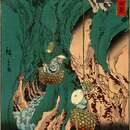en
names in breadcrumbs


Umbilicaria esculenta, the rock tripe, is a lichen of the genus Umbilicaria that grows on rocks. It has distribution across East Asia, including China, Japan, and Korea. Umbilicus is the latin word for "navel, middle, center", referring to the navel-like form of the lichen. The epithet, esculenta, means edible, as Umbilicaria esculenta is edible when prepared properly, being used as a food source and medicine. It is called iwatake (kanji: 岩茸 or 石茸) in Japanese and seogi (hangul: 석이; hanja: 石耳; literally "stone ear" or "rock ear") or seogi beoseot (hangul: 석이버섯; literally "stone ear mushroom") in Korean. The species name is based on the earlier basionym Gyrophora esculenta.
Derived from the past species name, synonyms are Gyrophora esculenta Miyoshi.
Two different types of polysaccharides are known to be the structural components, both a heteroglycan from the fungus and a glucan from the alga.[1] U. esculenta lichens have a dislike thallus, attached to the substrate with a central holdfast.[2] The thallus is also heteromerous (parts that are different in quality and number) and fully corticated (has a cortex and bark). Many of the Umbilicaria species are characterized by a veined or rugose thalline surface.[2] The fungus also has a vegetative reproductive strategy, meaning that it grows through fragmentation from the parent plant.
Umbilicaria esculenta is a saxicolous lichen; it grows on rocks and is known widely as the "rock tripe". It is usually found on at high altitude in East Asia.[3]
The algae in the U. esculenta lichen produce carbohydrates, using the carbohydrates to grow and reproduce. Different lichens need different amounts of light. This lichen is exposed on rock and desert soils, as well as on a leafy tree. It is found in East Asia; Japan, China, and Korea.
Lichens have a history in folk foods. U. esculenta is considered a delicacy where it is eaten in dishes, soups, or in salads.[4] It has been used as starvation food by Native Americans and early settlers. U. esculenta possesses nutritional properties, such as antioxidant, immune-boosting, and lipid peroxidation inhibitory properties.[4]
This fungus is used in laboratories, as lichen-derived glucans have been known to stimulate the functions of immune cells.[5] A study conducted that the fungus, U. escultenta, was evaluated for the phenotypic and functional maturation of dendritic cells after the treatment of extracted glucan.[6] The results concluded that the extracted glucan induced dendritic cell maturation.[6] Medicinal crops are designated as cultivated/semi cultivated plants for prevention/treatment of human/animal diseases. A study was conducted on the polysaccharides in lichens to determine tumor activities. The active glucan in U. esculenta has been isolated in pure form and inhibited the growth of tumors almost completely.[7]
In Europe, records from around the 15th century suggested that several lichens were in regular medicinal usage, with U. esculenta being one of them. It has numerous functions, including antithrombotic activity, antioxidant activity, melanogenesis inhibition, and inhibitory effect on the replication of HIV.[3] The methanolic extracts of U. esculenta have been studied and proven to have melanogenesis inhibitory effects.[8] The lichen is also used in vitro antiviral activity, treating inflammation, poisoning, and hemostasis.[8] In Canada and the United States, it is found in tea to treat tuberculosis and bleeding.[8] Having anti-inflammatory effects,[9] U. esculenta has also shown potent anti-melanoma effects, providing a promising strategy of melanoma therapy with the components from the extracts.[3]
Iwatake gathering at Kumano in Kishū, by Hiroshige II
Korean pan-fried Umbilicaria esculenta
[1][2][3][4][5][6][7][8][9][10][11][12]
:8 was invoked but never defined (see the help page).
:4 was invoked but never defined (see the help page).
:6 was invoked but never defined (see the help page).
:5 was invoked but never defined (see the help page).
:0 was invoked but never defined (see the help page).
:2 was invoked but never defined (see the help page).
:1 was invoked but never defined (see the help page).
:7 was invoked but never defined (see the help page).
:3 was invoked but never defined (see the help page).
Umbilicaria esculenta, the rock tripe, is a lichen of the genus Umbilicaria that grows on rocks. It has distribution across East Asia, including China, Japan, and Korea. Umbilicus is the latin word for "navel, middle, center", referring to the navel-like form of the lichen. The epithet, esculenta, means edible, as Umbilicaria esculenta is edible when prepared properly, being used as a food source and medicine. It is called iwatake (kanji: 岩茸 or 石茸) in Japanese and seogi (hangul: 석이; hanja: 石耳; literally "stone ear" or "rock ear") or seogi beoseot (hangul: 석이버섯; literally "stone ear mushroom") in Korean. The species name is based on the earlier basionym Gyrophora esculenta.